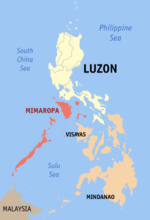Marinduque
The province of Marinduque was ranked number 1 by the Philippine National Police and Philippine Security Forces as the 2013 Most Peaceful Province of the country due to its low crime rate statistics alternately ranking with the province of Batanes yearly. Furthermore, for almost 200 years, the province is home to one of the oldest religious festivals of the country, the Moriones celebrated annually every Holy Week.
Etymology
The most accepted theory of the etymology of the province's name is a Hispanized corruption of either malindig or malindug, which means "stand tall" or "elegant", in reference to a potentially active volcano in the southern section of the island, the Mount Malindig.
In 1676, Domingo Navarette wrote in Tratados historicos..., "The island which the people from there call Minolo is named Mindoro by the Spaniards, and that of Malindic we call Marinduque." (trans. by E.H. Blaire and J.A. Robertson)
History
Spain 1521–1898
United States of America 1898–1942
Japan 1942–1945
Philippines 1946–present
Middle ages
The island was called Malindig in Tagalog and Malindog in Visayan languages. It was likely a constituent of the Kingdom of Luzon, due to the immediate Spanish claims to the island after the fall of Manila in May 1570.
It is possible that there were nobility who ruled Malindig since there are principalia or princely figures in Marinduque during Spanish rule.
Spanish rule
From the Visayan name Malindog, Marinduque became the name of the island in Castilian.
In 1571, Governor-General Miguel López de Legaspi had entrusted (encomienda) Marinduque to Fr. Pedro de Herrera, the first Augustinian priest who introduced Christianity to Marinduqueños.
Marinduque was part of the province of Balayan (now Batangas) in the 16th century, and of Mindoro from the 17th to 19th century.
Antoine-Alfred Marche, a French naturalist, carried out an archaeological investigation in Marinduque from April to July 1881. An abundant yield of urns, vases, gold ornaments, skulls, and other ornaments were found. He brought these to France in 40 crates. Part of it is said to be housed at the Musée de l'Homme ("museum of man") in France. The finds also included an image of wooden polytheistic religious statues (anito) which at the time were already called pastores by Marinduqueños.
One of the artifacts found by Marche also found its way to the National Museum of Natural History of the Smithsonian Institution in Washington, D.C. (Catalogue No. A127996-0, Department of Anthropology, NMNH, Smithsonian Institution). Fragile jarlets that were found were said to have travelled from China to Marinduque. Buried in a cave for centuries and excavated in the late 19th century, these were brought to Paris and one was then brought at the Smithsonian Institution museum.
First Philippine Republic
Marinduque, governed through the province of Mindoro, was a constituent of the first Philippine Republic from January 1899 to April 1901 under Pres. Emilio Aguinaldo.
During the Philippine–American War, Marinduque was the first province where American invaders established concentration camps. In the Battle of Pulang Lupa, under the direction of Colonel Maximo Abad, 250 Filipino soldiers defeated 54 American infantrymen.
American rule
Col. Abad after capturing the Americans later surrendered on 15 April 1901, upon orders from Pres. Aguinaldo and due to the capture of Gov. Martin Lardizabal and two other officials who were held hostage by the Americans at Fort Santiago.
On 23 June 1902, by virtue of Act No. 423, the US-Philippine Commission annexed the islands of Mindoro (now two separate provinces) and Lubang (now part of Occidental Mindoro) to the province. Four months later, on the 10th of November, Marinduque was annexed to the province of Tayabas (now Quezon) by virtue of an Act No. 499.
On 21 February 1920, Act No. 2280 was passed by the Philippine Congress, reestablishing Marinduque as a separate province.
According to Henry Otley Beyer, an American anthropologist, while many other accidental discoveries and finds have been recorded from time to time and European and Filipino scientists had casually explored a few burial caves and sites, no systematic work had been done anywhere else prior to these explorations. After Marche, the next important archaeological work was undertaken by Dr. Carl Gunthe in the Visayas Island Group in 1922.
Commonwealth of the Philippines
In November 1935, Marinduque became a province of the Commonwealth of the Philippines under Pres. Manuel Quezon. The Philippine Commonwealth Army was stationed in the province; the general headquarters was active from 1935 to 1942.
Japanese occupation
In 1942, during the Second World War, Japanese Imperial forces landed on Marinduque. The province was re-annexed to Tayabas, but re-established as an independent province in 1945.
Second Philippine Republic
In October 1943, Marinduque became a province of the Second Philippine Republic under Pres. Jose Laurel. The sovereign, however, was the Japanese emperor.
In 1945, combined American and Filipino troops liberated the province from Japanese forces, returning the province to the Commonwealth of the Philippines under Pres. Sergio Osmeña. In addition to the return of the Philippine Commonwealth Army, the Philippine Constabulary was also stationed in the province. These were active from 1945 to 1946.
Third Philippine Republic to present
Archaeological findings that help inform Marinduque's history are exhibited at the Marinduque Museum in Poblacion at Boac and in foreign museums. The artifacts are to be analysed to aid the historiography of the island and the province.

